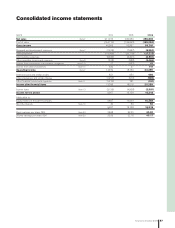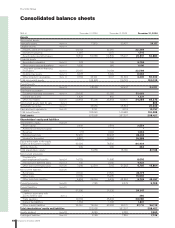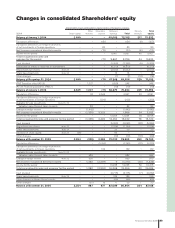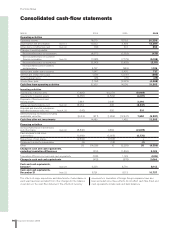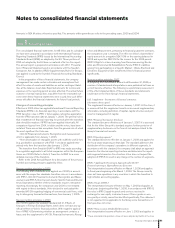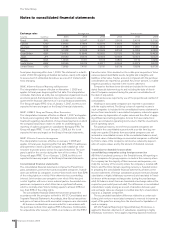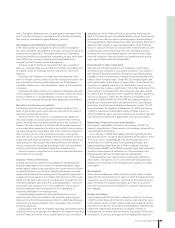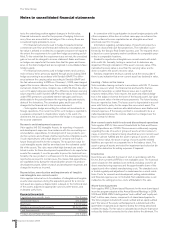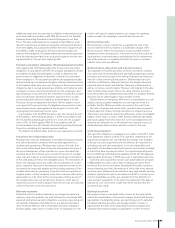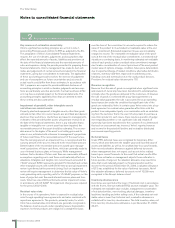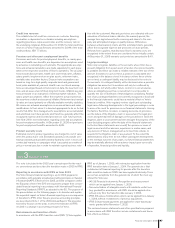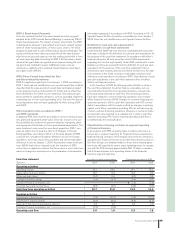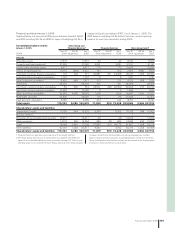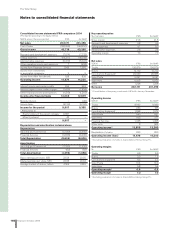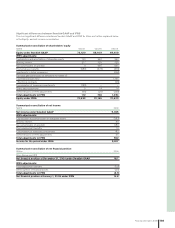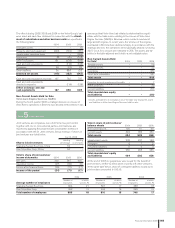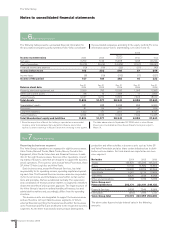Volvo 2006 Annual Report Download - page 100
Download and view the complete annual report
Please find page 100 of the 2006 Volvo annual report below. You can navigate through the pages in the report by either clicking on the pages listed below, or by using the keyword search tool below to find specific information within the annual report.
96 Financial information 2006
The Volvo Group
Note 2 Key sources of estimation uncertainty
Key sources of estimation uncertainty
Volvo’s signifi cant accounting principles are set out in note 1,
Accounting Principles and conform to IFRS as adopted by the EU.
The preparation of Volvo’s Consolidated Financial Statements
requires the use of estimates, judgements and assumptions that
affect the reported amounts of assets, liabilities and provisions at
the date of the fi n ancial statements and the reported amounts of
sales and expenses during the periods presented. In preparing these
fi n a ncial statements, Volvo’s management has made its best esti-
mates and judgements of certain amounts included in the fi n ancial
statements, giving due consideration to materiality. The application
of these accounting principles involves the exercise of judgement
and use of assumptions as future uncertainties and, as a result,
actual results could differ from these estimates. In accordance with
IAS 1, preparers are required to provide additional disclosure of
accounting principles in which estimates, judgments and assump-
tions are particularly sensitive and which, if actual results are differ-
ent, may have a material impact on the fi nancial statements. The
accounting principles applied by Volvo that are deemed to meet
these criteria are discussed below:
Impairment of goodwill, other intangible assets
and other non-current assets
Property, plant and equipment, intangible assets, other than good-
will, and certain other non-current assets are amortized and depreci-
ated over their useful lives. Useful lives are based on management’s
estimates of the period that the assets will generate revenue. If, at
the date of the fi n ancial statements, there is any indication that a
tangible or intangible non-current asset has been impaired, the
recoverable amount of the asset should be estimated. The recover-
able amount is the higher of the asset’s net selling price and its
value in use, estimated with reference to management’s projections
of future cash fl ows. If the recoverable amount of the asset is less
than the carrying amount, an impairment loss is recognized and the
carrying amount of the asset is reduced to the recoverable amount.
Determination of the recoverable amount is based upon manage-
ment’s projections of future cash fl o ws, which are generally made by
use of internal business plans or forecasts. While management
believes that estimates of future cash fl o ws are reasonable, different
assumptions regarding such cash fl o ws could materially affect our
valuations. Intangible and tangible non-current assets amounted to
73,997 whereof 8,849 represents goodwill. For Goodwill and certain
other intangible assets with indefi nite life-time an annual impairment
review is performed at the year-end closing. Such an impairment
review will require management to determine the fair value of Volvo’s
cash generating units, reporting units for US GAAP purposes, on the
basis of projected cash fl ows and internal business plans and fore-
casts. Volvo has since 2002 performed a simliar impairment review
in accordance with US GAAP. No impairment charges were required
for the period 2002–2006.
Residual value risks
In the course of its operations, Volvo is exposed to residual value
risks through operating lease agreements and sales combined with
repurchase agreements. The products, primarily trucks, for which
Volvo has a residual value commitment, are generally recognized in
the balance sheet as assets under operating leases. Depreciation
expenses for these products are charged on a straight-line basis
over the term of the commitment in amounts required to reduce the
value of the product to its estimated net realizable value at the end
of the commitment. Estimated impairment losses are immediately
charged to income. The estimated net realizable value of the prod-
ucts at the end of the residual value commitments is monitored indi-
vidually on a continuing basis. In monitoring estimated net realizable
value of each product under a residual value commitment, manage-
ment makes consideration of current price-level of the used product
model, value of options, mileage, condition, future price deterioration
due to expected change of market conditions, alternative distribution
channels, inventory lead-time, repair and reconditioning costs,
handling costs and overhead costs in the used product divisions.
Provisions for residual value risk amount to 781.
Revenue recognition
Revenue from the sale of goods is recognized when signifi cant risks
and rewards of ownership have been transferred to external parties,
normally when the goods are delivered to the customers. If, however,
the sale of goods is combined with a buy-back agreement or a
re sidual value guarantee, the sale is accounted for as an operating
lease transaction under the condition that signifi cant risks of the
goods are retained by Volvo. In certain cases Volvo enters into a buy-
back agreement or residual value guarantee after Volvo sold the
product to an independent party or in combination with an undertak-
ing from the customer that in the event of a buy-back to purchase a
new Volvo product. In such cases, there may be a question of judge-
ment regarding whether or not signifi cant risks and rewards of
ownership have been transferred to the customer. If it is determined
that such an assessment was incorrect, Volvo’s reported revenue
and income for the period will decline and instead be distributed
over several reporting periods.
Deferred taxes
Under IFRS, deferred taxes are recognized for temporary differ-
ences, which arise between the taxable value and reported value of
assets and liabilities as well as for unutilized tax-loss carryforwards.
Volvo records valuation allowances against deferred tax assets
where management does not expect such assets to be realized
based upon current forecasts. In the event that actual results differ
from these estimates or management adjusts these estimates in
future periods, changes in the valuation allowance may need to be
done that could materially impact our fi n ancial position and the
income for the period. At December 31, 2006, a valuation allowance
of 213 was established for the value of deferred tax assets. Net of
this valuation allowance, deferred tax assets net of 10,069 were
recognized in the Group’s balance sheet.
Inventory obsolescence
Inventories are reported at the lower of historical cost, in accordance
with the fi r st-in, fi r st-out method (FIFO), and net realizable value. The
estimated net realizable value includes management consideration
of out-dated articles, over-stocking, physical damages, inventory-
lead-time, handling and other selling costs. If the estimated net real-
izable value is lower than historical cost, a valuation allowance is
established for inventory obsolescence. The total inventory value, net
from inventory obsolescence allowance, is per December 31, 2006,
34,211.
Notes to consolidated financial statements



